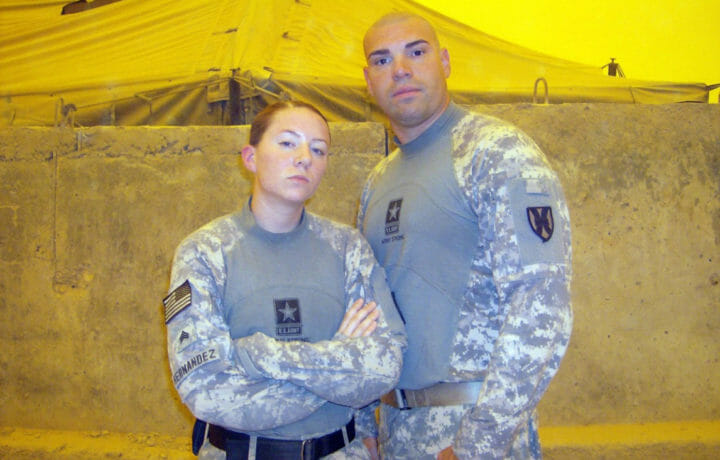Weapons designers are wily and inventive creatures, and if not for budgets and shifting priorities, the American soldier today might look a lot more like a G.I. Joe character (and our enemies, a lot more like Cobra). But not every military project lives to see the light of day.
5 Canceled Military Projects
Here are 5 military projects that were canceled that would have changed everything.
1. Warriors from the Future
Uniforms with nanotechnology and exoskeletons? A system of sensors constantly monitoring your vital signs? Helmets with a Call of Duty-style heads-up display, complete with 360-degree battlefield awareness and maps streamed across a wireless network? That was the plan… twenty years ago! It was always a long shot that the Future Force Warrior concept would materialize on the battlefield. Alas, it died with the rest of the $32 billion Future Combat System Initiative. One thing did emerge from it, however: the Army Combat Shirt.
2. A Manned Space Station
During the Gemini program, which was NASA’s effort to develop techniques and technologies for the Apollo program, the Defense Department took a hard look at the visuals of Earth our astronauts were getting, and realized right away that trained soldiers could do some pretty good reconnaissance work up there. Thus was born the Manned Orbiting Laboratory, a project that made it all the way to the hardware stage before being canceled. In part, robotic automation advanced faster than anyone anticipated, and was a better value for that sort of work. In part, the Vietnam War was proving expensive, and defense dollars had to come from somewhere. Notably, the service members selected and trained to crew the Manned Orbiting Laboratory did go to space! They were transferred to NASA (most astronauts are active duty or retired service members even to this day), and flew on various Space Shuttle missions.
3. A Nuclear-Powered Jet
There was a good stretch of time after the United States detonated the atomic bomb that scientists and engineers worked themselves silly finding new ways of applying fission power to conventional problems. A nuclear-powered jet was a no brainer! The idea was that our long range bomber fleet had one fatal limitation if we wanted to keep the Soviets at bay. With conventional fuel, you absolutely must keep refueling. But a nuclear-powered plane could fly for weeks at a time. It would be the airborne equivalent of the nuclear submarine fleet. The Convair X-6 was one design. Alas, the trouble of flying fissile material outweighed the benefits, and the whole program was ended in 1961.
4, Railroad cars… with nuclear missiles inside.
In nuclear warfare circles, “first strike” was no joke. For the younger readers, during the insanity that was the Cold War, the U.S. and Soviet Union built astounding and terrifying numbers of nuclear missiles capable of striking each other. But who would strike first? The problem with being on the receiving end of an all-out nuclear attack is that those nuclear weapons are going to be aimed at your nuclear weapons, so that you can’t strike back. And since the locations of nuclear launch sites were a tough secret to keep, the question was how the U.S. would respond in a worst case scenario. Enter the humble railroad. The Peacekeeper Rail Garrison was a railroad car launcher for intercontinental ballistic missiles. The idea was that if things got hot between the U.S. and U.S.S.R., the trains—prepositioned at several installations across the country—would start rolling. It would be impossible for the Soviets to hit them all, thus providing retaliatory capabilities. Only a prototype was built, and the program was abandoned in 1991.
5. Rifles That Fire… Rockets?
The very, very basic idea behind rifles is easy enough to understand: Pull the trigger, which causes the primer in a round of ammunition to spark, which ignites gunpowder, which releases gas and blasts a projectile forward. The barrel is grooved on the inside, which causes the round to spin, increasing stability and accuracy. By definition, the very fastest that round will ever fly is the moment it reaches the end of the barrel. After that, it’s in the hands of Isaac Newton. But what if there were a way to make that round go faster after it leaves the barrel? That is what engineers asked when they developed the Gyrojet, a type of rifle that fired tiny rocket-powered projectiles. They left the barrel relatively slowly, but quickly built speed as the bullets’ solid rockets burned. It was a great idea because you could make guns much lighter, as the chambers and barrels did not need to endure the explosive pressure of ignited gunpowder; and fire with less recoil, for the same reason. Alas, the U.S. was mired in Vietnam, which limited the time and money available for continued weapons development—and they needed it: Gyrojets lacked the precision and reliability necessary for military adoption. Enthusiasts today collect the rare rifles and their valuable ammunition. (A single rocket bullet runs about $100, so make every shot count.)
Imagining the Art of the Possible
But what the world might have been! Paratroopers carrying rocket guns and enhanced with nanotechnology jumping from the backs of nuclear powered planes while soldiers monitor the situation from a space station and deploy the railroad missiles… science fiction needs to try a little harder if it wants to keep up with a battlefield that was almost science fact.




